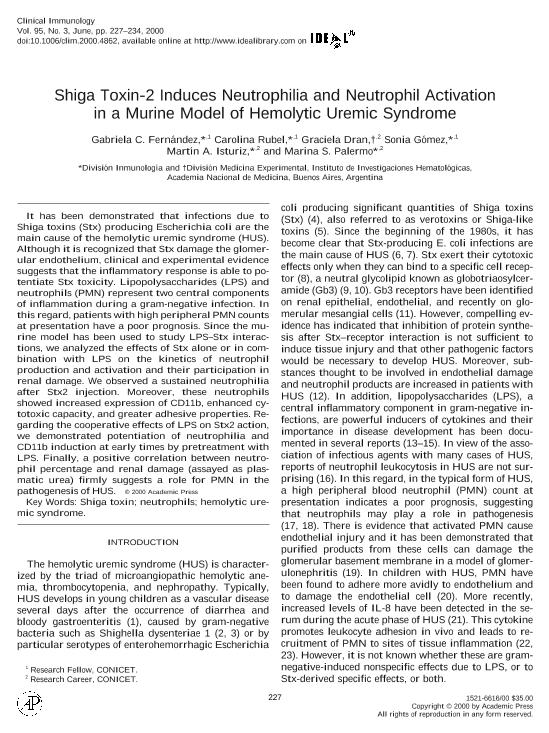Artículo
Shiga toxin-2 induces neutrophilia and neutrophil activation in a murine model of hemolytic uremic syndrome
Fernández, Gabriela Cristina ; Rubel, Carolina; Dran, Graciela Isabel
; Rubel, Carolina; Dran, Graciela Isabel ; Gómez, Sonia Alejandra
; Gómez, Sonia Alejandra ; Isturiz, Martín Amadeo
; Isturiz, Martín Amadeo ; Palermo, Marina Sandra
; Palermo, Marina Sandra
 ; Rubel, Carolina; Dran, Graciela Isabel
; Rubel, Carolina; Dran, Graciela Isabel ; Gómez, Sonia Alejandra
; Gómez, Sonia Alejandra ; Isturiz, Martín Amadeo
; Isturiz, Martín Amadeo ; Palermo, Marina Sandra
; Palermo, Marina Sandra
Fecha de publicación:
12/2000
Editorial:
Academic Press Inc Elsevier Science
Revista:
Clinical Immunology
ISSN:
1521-6616
Idioma:
Inglés
Tipo de recurso:
Artículo publicado
Clasificación temática:
Resumen
It has been demonstrated that infections due to Shiga toxins (Stx) producing Escherichia coli are the main cause of the hemolytic uremic syndrome (HUS). Although it is recognized that Stx damage the glomerular endothelium, clinical and experimental evidence suggests that the inflammatory response is able to potentiate Stx toxicity. Lipopolysaccharides (LPS) and neutrophils (PMN) represent two central components of inflammation during a gram-negative infection. In this regard, patients with high peripheral PMN counts at presentation have a poor prognosis. Since the murine model has been used to study LPS-Stx interactions, we analyzed the effects of Stx alone or in combination with LPS on the kinetics of neutrophil production and activation and their participation in renal damage. We observed a sustained neutrophilia after Stx2 injection. Moreover, these neutrophils showed increased expression of CD11b, enhanced cytotoxic capacity, and greater adhesive properties. Regarding the cooperative effects of LPS on Stx2 action, we demonstrated potentiation of neutrophilia and CD11b induction at early times by pretreatment with LPS. Finally, a positive correlation between neutrophil percentage and renal damage (assayed as plasmatic urea) firmly suggests a role for PMN in the pathogenesis of HUS. (C) 2000 Academic Press.
Palabras clave:
Hemolytic Uremic Syndrome
,
Neutrophils
,
Shiga Toxin
Archivos asociados
Licencia
Identificadores
Colecciones
Articulos(IMEX)
Articulos de INST.DE MEDICINA EXPERIMENTAL
Articulos de INST.DE MEDICINA EXPERIMENTAL
Citación
Fernández, Gabriela Cristina; Rubel, Carolina; Dran, Graciela Isabel; Gómez, Sonia Alejandra; Isturiz, Martín Amadeo; et al.; Shiga toxin-2 induces neutrophilia and neutrophil activation in a murine model of hemolytic uremic syndrome; Academic Press Inc Elsevier Science; Clinical Immunology; 95; 3; 12-2000; 227-234
Compartir
Altmétricas



